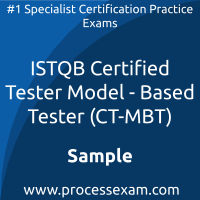 You have to pass the CT-MBT exam to receive the certification from ISTQB. To increase the effectiveness of your study and make you familiar with the actual exam pattern, we have prepared this ISTQB Model-Based Tester sample questions. Our Sample ISTQB Certified Tester - Model-Based Tester Practice Exam will give you more insight about both the type and the difficulty level of the questions on the ISTQB CT - Model-Based Tester exam.
You have to pass the CT-MBT exam to receive the certification from ISTQB. To increase the effectiveness of your study and make you familiar with the actual exam pattern, we have prepared this ISTQB Model-Based Tester sample questions. Our Sample ISTQB Certified Tester - Model-Based Tester Practice Exam will give you more insight about both the type and the difficulty level of the questions on the ISTQB CT - Model-Based Tester exam.
However, we are strongly recommending practice with our Premium ISTQB Certified Tester - Model-Based Tester (CT-MBT) Practice Exam to achieve the best score in your actual ISTQB CT-MBT Exam. The premium practice exam questions are more comprehensive, exam oriented, scenario-based and exact match of ISTQB Certified Tester - Model-Based Tester exam questions.
ISTQB Model-Based Tester Sample Questions:
c) To ignore project constraints
b) It requires a particular syntax in the user stories, which requires all user stories to be written in the same way
c) Coverage
b) The models are always correct because they are generated by algorithms that are already tested
Answers:
|
Question: 01 Answer: d |
Question: 02 Answer: c |
Question: 03 Answer: b |
Question: 04 Answer: c |
Question: 05 Answer: b |
|
Question: 06 Answer: b |
Question: 07 Answer: a |
Question: 08 Answer: d |
Question: 09 Answer: a |
Question: 10 Answer: c |
If you find any errors or typos in ISTQB Certified Tester - Model-Based Tester (CT-MBT) sample question-answers or online ISTQB CT - Model-Based Tester practice exam, please report them to us on feedback@processexam.com
